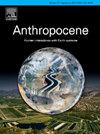Assessing the impacts of anthropogenic-induced land use/land cover changes in wetlands using remotely sensed information: A systematic state-of-the-art review and future directions
IF 3.9
2区 地球科学
Q2 ENVIRONMENTAL SCIENCES
引用次数: 0
Abstract
Researchers have consistently strived to improve the discriminability of various land cover types, particularly between aquatic and vegetative areas, through diverse remote sensing techniques. This is crucial for conserving wetlands that have been degraded and undergone land use changes due to anthropogenic activities. This paper performs a meta-analysis and provides a systematic review of studies related to the land use classification process. After an extensive search, 74 papers were selected (PRISMA method) for detailed analysis. The study aims to introduce, investigate, and evaluate remote sensing methodologies for wetland land use classification and assess how these methods impact the detection of wetland change patterns. The findings reveal that 10 % of the studies utilized an object-based approach with optimization based on a trial-and-error method. Additionally, wetland researchers prefer combining Landsat data with supervised machine learning classification methods (82 %). This paper suggests conducting an in-depth examination of integrating dynamic training sample selection methods with object-based approaches, automating the optimization of segmentation parameters, and employing transfer learning techniques for classification. Moreover, the review highlights existing gaps and proposes future research avenues to advance research. For instance, improving accuracy is possible through explainable artificial intelligence and replacing the weak and commonly used Kappa with new evaluation metrics. Additionally, a new concept framework, “Aquatic Harmony/Aquatic Disruption,” and a wetland risk assessment map have been introduced, offering a comprehensive perspective on the impact of anthropogenic activities on wetlands. This review may open new horizons for wetland researchers by providing alternative approaches for the future.
利用遥感信息评估湿地人为土地利用/土地覆盖变化的影响:系统的最新回顾和未来方向
研究人员一直在努力通过各种遥感技术提高各种土地覆盖类型,特别是水生和植被区之间的可辨别性。这对于保护因人为活动而退化和发生土地利用变化的湿地至关重要。本文进行了一项元分析,并对与土地利用分类过程相关的研究进行了系统的回顾。经过广泛的检索,选择74篇论文(PRISMA方法)进行详细分析。本研究旨在介绍、研究和评价湿地土地利用分类的遥感方法,并评估这些方法对湿地变化模式检测的影响。研究结果显示,10% %的研究利用了基于对象的方法,并基于试错法进行优化。此外,湿地研究人员更喜欢将Landsat数据与监督机器学习分类方法相结合(82% %)。本文建议深入研究将动态训练样本选择方法与基于对象的方法相结合,自动优化分割参数,并采用迁移学习技术进行分类。此外,该综述强调了现有的差距,并提出了未来的研究途径来推进研究。例如,通过可解释的人工智能和用新的评估指标取代弱的和常用的Kappa来提高准确性是可能的。此外,引入了一个新的概念框架“水生和谐/水生破坏”和湿地风险评估图,为人类活动对湿地的影响提供了一个全面的视角。这一综述为未来的湿地研究提供了新的途径,为湿地研究开辟了新的视野。
本文章由计算机程序翻译,如有差异,请以英文原文为准。
求助全文
约1分钟内获得全文
求助全文
来源期刊

Anthropocene
Earth and Planetary Sciences-Earth and Planetary Sciences (miscellaneous)
CiteScore
6.30
自引率
0.00%
发文量
27
审稿时长
102 days
期刊介绍:
Anthropocene is an interdisciplinary journal that publishes peer-reviewed works addressing the nature, scale, and extent of interactions that people have with Earth processes and systems. The scope of the journal includes the significance of human activities in altering Earth’s landscapes, oceans, the atmosphere, cryosphere, and ecosystems over a range of time and space scales - from global phenomena over geologic eras to single isolated events - including the linkages, couplings, and feedbacks among physical, chemical, and biological components of Earth systems. The journal also addresses how such alterations can have profound effects on, and implications for, human society. As the scale and pace of human interactions with Earth systems have intensified in recent decades, understanding human-induced alterations in the past and present is critical to our ability to anticipate, mitigate, and adapt to changes in the future. The journal aims to provide a venue to focus research findings, discussions, and debates toward advancing predictive understanding of human interactions with Earth systems - one of the grand challenges of our time.
 求助内容:
求助内容: 应助结果提醒方式:
应助结果提醒方式:


